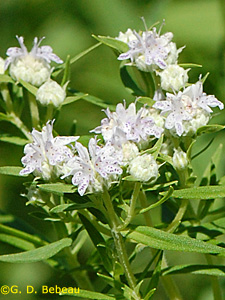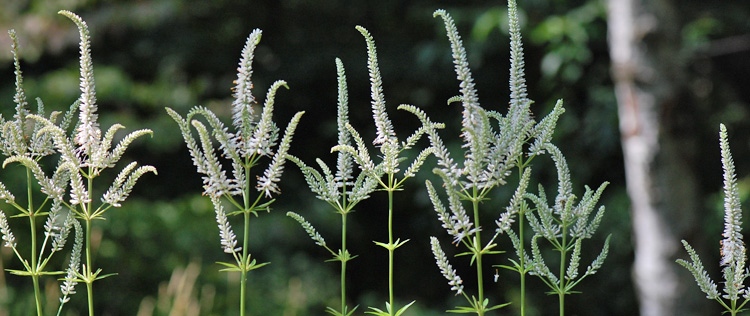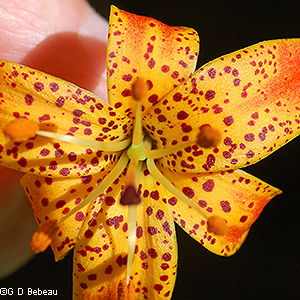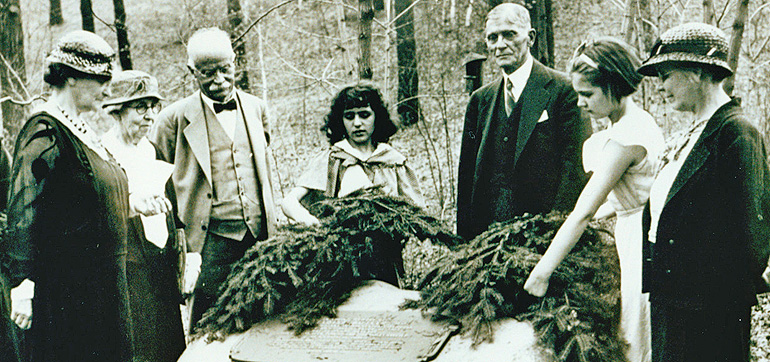Friends of the Wild Flower Garden
A web of present and past events

These short articles are written to highlight connections of the plants, history and lore of the Eloise Butler Wildflower Garden with different time frames or outside connections. A web of intersections.
This month children are coming to the Garden and we ask your help with funding their transportation costs. We look forward to the Wildflower Garden in July and the mid-summer color of the upland. We highlight the lilies of the Garden, look at the historical circumstances that 90 years ago, resulted in the Eloise Butler memorial in the Garden and conclude with notes on the hottest summer on record.
This Month
Kids Visits to the Garden Need Support
The Butler Memorial Association
Kids Visits to the Garden Need Support

Help connect K-12 students with nature at the Eloise Butler Wildflower Garden.
Stop at the Garden Welcome Kisok and pick up our post card about the program - pass it along!
Structured visits by school age children are back on the program at the Wildflower Garden this season with the Friends funding transportation costs. The first group came to the Garden on May 17 from Whittier Elementary.
On Garden field trips, naturalists with the Minneapolis Park and Recreation Board (MPRB) inspire kids with wonder and curiosity about the natural world and connect a new generation to this special place. Not all schools have funds for bus transportation to the Garden. That's why the Friends and MPRB are committed to ensuring the file trips are financially accessible.
You can help by donating to this program. MORE DETAILS AT THIS LINK
The Wildflower Garden in July

Pycnanthemum virginianum
During the month of July, we make the transition from the early summer flowers of June to late summer flowers of mid July and August. Some of the early summer blooming plants continue their bloom period well into the late summer period. Others are now past for the year. Color will be concentrated in the Upland Garden and in the wetland.
- Look for the Mountain Mint and Virgin's Bower in the upland.
- A group of tall easily seen plants will on display.
The lilies will bloom (see next article)
Culver's Root will raise its white spikes in the upland and Bugbane will raise its white spikes in the woodland, and look for the tall Cow Parsnip in the wetland. - As the month progresses the first of the yellow composites will begin an extended showing of yellow in the upland. The Smooth Oxeye and the Stiff Coreopsis will be the first.
- In the wetland Queen of the Meadow will be prolific in bloom all along the boardwalk. These dense white flower displays attact many bees and insects.
- Interested in summer programs at the Garden? - visit the Garden’s website for a listing.
- Here is a photo reference to an entire cast of mid to late summer blooming plants - as they bloom at different times, each visit will present something different.
Below: A grouping of Culver's Root spikes, (Veronicastrum virginicum)

Lilies of the Garden
Six plants known as lilies are present in the Garden plus one called a lily but really in the Iris family. Two others are historical. We cover them all here.

Among the lilies of the genus Lilium are those commonly called "Turk's-cap" so named for the form created by the petals when in the fully recurved position touching or almost touching each other and the flower stem. The flowers are all pendant in large arrays. The name is correctly assigned to Lilium superbum which has been introduced into Minnesota for garden planting and is native to a number of states in the Southeast. Eloise Butler noted its seedpods in the Garden in September 1908 and planted more the same year, obtained from a Pennsylvania Nursery. As this was the first time it appears in her log, why was this non-native in the Garden? Had it been planted prior in Wirth Park and seeds ended up in the Garden? OR did she misidentify the seed pod and instead it was our native Michigan Lily, L. michiganense?
We know for certain from her log that years later Curator Martha Crone planted the Michigan Lily. Today both exist in the Upland part of the Garden. Both form tall stems with multiple flower heads. The links to the identification pages will give you the key details of difference but the most reliable identification key it the green star at the base of the petals in the Turk's-cap and the lack of the star in the Michigan.
A third lily with this form that was brought into the area for ornamental purposes is the Tiger Lily (L. lancifolium), which has never been in the Garden and is best identified by the small bubils that form in the leaf axils.

Lilium michiganense
lacks the green star at the petal base.

Lilium superbum
shows the green star at the petal base.
Below: Former Gardener Cary George with a stand of Turk's-cap lilies, ca. 2000. Friends photo.

The next lily is the Canada Lily, L. canadenses where the petals do not fully recurve and the outer color of the petals is yellow with reddish tints. It also has pendant flowers in a large array. It is not native to the state but to states farther east and to Canada. Eloise introduced it in 1910 and she and Martha Crone planted it a number of times.

Of our state's two native lilies we now come to the Wood Lily, L. philadelphicum, which has the widest range of any North American lily. Unlike those already mentioned, the flowers are held upright in the manner of an asiatic lily, and only one to three per stem. Unlike the asiatics, the petal bases are very long and clawed, leaving some space between them. It arrived in the Garden in 1909 and is found in most counties of Minnesota except 18 in the southwest and south central. The photo below is from a Kodachrome taken by Martha Crone on June 22, 1949.

After the Upland Garden was established in 1944, Martha Crone brought in two other no-native lilies, the Carolina Lily, Lilium michauxii, and Gray's Lily, Lilium carolinanum. Even though she planted them several times, they were not successful and after they died out, later Curators have not replanted them as they are not native.
We now move out of the Lilium genus and into Hemerocallis, the Day Lilies, and come to two lilies that can be considered decorative or invasive. The first is the Yellow Day Lily, H. lilioasphodelus. Martha Crone introduced it in 1949 in the new Upland Garden. The flowers are trumpet shaped and fragrant. The second is more well known from roadside displays, the Orange Day Lily, sometimes called the Ditch Lily, H. fulva. The flowers are more upright, not fragrant, sometimes doubled, and the plant is a super spreader. Plant with caution. The underground tubers can send out underground runners to create new plants feet away from the parent. It was also a Crone introduction, in 1947.


The final entry is the Blackberry Lily or Leopard Flower, Belamcanda chinensis, not a lily at all but a member of the Iris family, as the leaves tell you. These lily-like flowers are upright, borne in multiple clusters, but only one per cluster opens at a time. It may have arrived in the Garden as a gift. It is listed on the 1986 plant census and has stayed around.

Background
The six flower petals of the true lilies are actually composed on 3 petals and 3 sepals which usually have the same color and shape and are thus referred to as tepals. The leaves of some are in whorls and in others alternate on the stem with the floral array at the top. The day liles differ by having strap-like leaves that rise from the base with the flower stem leafless, but the flower parts are the same as the true lilies. In both there are 6 stamens and a 3-part ovary which produces a 3-chambered seed capsule.
Eloise Butler was a key advocate of forming the Garden in 1907 and was appointed Curator in 1911. After her death in 1933, Martha Crone became Curator until 1959.
The Eloise Butler Memorial Tablet

Frequent visitors to the Eloise Butler Wildflower Garden will be aware of the large boulder that bears a memorial tablet for Eloise Butler. It is located near the Martha Crone Shelter. Many may not know how it came to be.
We go back 90 years to the memorial ceremony for Eloise on May 5, 1933 in the Garden. The last person to speak was the Superintendent of Parks, Theodore Wirth. He suggested that a year from today this same group of friends gather to place a bronze tablet on a boulder near the tree (just planted) to perpetuate the dedication, and those friends then made preparation to raise the funds necessary for this purpose.
The organization formed was the Eloise Butler Memorial Association with Miss Jennie Hall (science supervisor of Minneapolis Public Schools) as head. A governing committee of five persons, headed by Clara Leavitt (retired teacher), with Martha Crone, Elizabeth Foss (North High teacher), Dr. Otto Schussler and Gratia Countryman (Minneapolis Librarian) were in charge of forming other committees and designing the memorial. There were several suggested dedications which were submitted to Martha Crone (who replaced Eloise as Garden Curator) for her approval and for her to sample the preferences of garden visitors as to the wording. A fund raising campaign was initiated with the suggested donation being limited to no more than one dollar. The committee felt that they must raise the funds independently so as to "prove to Mr. Wirth and the Park board that the Reserve (The Wildflower Garden) has many friends." Seventy-five persons contributed one dollar, many others lesser amounts and several organizations contributed more. The dedication recommended by the committee was approved by Martha and all interested others and the bronze tablet was cast, using the design of Mr. Melchior of Flour City Ornamental Iron Works.
The tablet was dedicated on Arbor Day, May 4 1934, with Francis Gross, Vice President, accepting on behalf of the Board of Park Commissioners.
Below: At the dedication of the memorial tablet are (l. to r.) Miss Elizabeth Foss, Botany teacher at North High School (She made the presentation of the tablet); Clara Leavitt, fellow teacher of Eloise; Minneapolis Parks Superintendent Theodore Wirth; Audrey Kelly; Parks Vice President Frances A. Gross; Dolores Hoiby and Jennie Hall, Science Supervisor of the Minneapolis Public Schools. Kelly and Hoiby are shown lifting away the green boughs which covered the tablet before the unveiling. Photo courtesy Minnesota Historical Society, Martha Crone Collection

The Hottest Summer
Historical Note
When the year 1936 began with 36 consecutive days of sub-zero minimums including one day of -34 F in January, there was little indication of the historic high temperatures to be reached six months later.
There was no rain during the summer from mid June until August 15th. July would become the hottest July in local recorded history with the highest temperature in local recorded history of 107.8 degrees on July 14th. Altogether there were 14 days of temperatures at 100 degrees and above during July. This record still stands today. Garden Curator Martha Crone planted a few species but she noted on July 28th that everything was dried up and yet it would be another 18 days before it would rain. There would be several good rainfalls in August after the half inch on August 15th, but from September through the end of the year, moisture would once again be slight.
All selections published in 2023